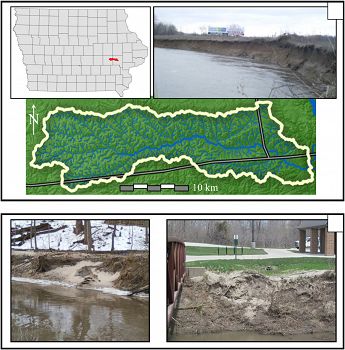ARCHIVED CONTENT: In December 2020, the CZO program was succeeded by the Critical Zone Collaborative Network (CZ Net)
×
Papanicolaou et al., 2017
Understanding mass fluvial erosion along a bank profile: Using PEEP technology for Quantifying Retreat Lengths and Identifying Event Timing
Papanicolaou, A.N., Wilson, C.G., Tsakiris, A.G., Sutarto, T.E., Bertrand, F., Rinaldi, M., Dey, S., and Langendoen, E. (2017)
Earth Surface Processes and Landforms
-
IML, INVESTIGATOR
-
IML, INVESTIGATOR
Abstract
The Clear Creek, IA, USA watershed. (a) Monitoring location near the mouth of Clear Creek. (b) Other images of the site showing sand deposition on the bank face. [Colour figure can be viewed at wileyonlinelibrary.com]
The Clear Creek, IA, USA watershed. (a) Monitoring location near the mouth of Clear Creek. (b) Other images of the site showing sand
deposition on the bank face. [Colour figure can be viewed at wileyonlinelibrary.com]
This study provides fundamental examination of mass fluvial erosion along a stream bank by identifying event timing, quantifying retreat lengths, and providing ranges of incipient shear stress for hydraulically driven erosion. Mass fluvial erosion is defined here as the detachment of thin soil layers or conglomerates from the bank face under higher hydraulic shear stresses relative to surface fluvial erosion, or the entrainment of individual grains or aggregates under lower hydraulic shear stresses. We explore the relationship between the two regimes in a representative, US Midwestern stream with semi-cohesive bank soils, namely Clear Creek, IA. Photo-Electronic Erosion Pins (PEEPs) provide, for the first time, in situ measurements of mass fluvial erosion retreat lengths during a season. The PEEPs were installed at identical locations where surface fluvial erosion measurements exist for identifying the transition point between the two regimes. This transition is postulated to occur when the applied shear stress surpasses a second threshold, namely the critical shear stress for mass fluvial erosion. We hypothesize that the regimes are intricately related and surface fluvial erosion can facilitate mass fluvial erosion. Selective entrainment of unbound/exposed, mostly silt-sized particles at low shear stresses over sand-sized sediment can armor the bank surface, limiting the removal of the underlying soil. The armoring here is enhanced by cementation from the presence of optimal levels of sand and clay. Select studies show that fluvial erosion strength can increase several-fold when appropriate amounts of sand and clay are mixed and cement together. Hence, soil layers or conglomerates are entrained with higher flows. The critical shear stress for mass fluvial erosion was found to be an order of magnitude higher than that of surface fluvial erosion, and proceeded with higher (approximately 2–4 times) erodibility. The results were well represented by a mechanistic detachment model that captures the two regimes.
Citation
Papanicolaou, A.N., Wilson, C.G., Tsakiris, A.G., Sutarto, T.E., Bertrand, F., Rinaldi, M., Dey, S., and Langendoen, E. (2017): Understanding mass fluvial erosion along a bank profile: Using PEEP technology for Quantifying Retreat Lengths and Identifying Event Timing. Earth Surface Processes and Landforms. DOI: 10.1002/esp.4138
 This Paper/Book acknowledges NSF CZO grant support.
This Paper/Book acknowledges NSF CZO grant support.
Explore Further



